

Ranking number one on Google should not be your only objective for SEO in your eCommerce store. In 2025, buyers in the USA may find your products from ChatGPT, support resources, Shopify store set-up guides, and experiences shared on Reddit regarding eCommerce solutions, and they may never visit your site.
Additionally, Google AI Overview features are capturing a significant portion of the clicks from our results, causing them to appear further down the page. For the first time that we have noticed more impressions but fewer clicks. Over 60% of searches now result in "no click".

The spin that is positive is that while we are seeing a decrease in clicks, DecodeUp is still providing better quality traffic for our clients through eCommerce SEO strategy, no matter the lower numbers. Our proven eCommerce systems, like our Shopify website design and ERP/CRM, are improving engagement on all fronts and getting better quality leads and conversions from the people we do have visit.

We will be discussing the eCommerce SEO strategy that generates 250K+ monthly visitors for our eCommerce clients, which is ranking for thousands of keywords, including the ones that brought you here.
Are you new to SEO? This eCommerce SEO technique assumes your familiarity with the fundamentals of SEO processes, such as keyword research and on-page eCommerce SEO strategies. If you're simply trying to understand SEO, check out the original eCommerce SEO Basics tutorial, then come back and improve your participatory approach.
In this guide, you’re going to discover how to:
Before you begin your keyword research or writing product descriptions, you need to choose what success looks like for your eCommerce business.
The biggest challenge we see eCommerce store owners make is focusing on ranking and traffic rather than on leads and revenue. This process should drive qualified leads, lower customer acquisition costs, and increase brand awareness within a US-based audience.
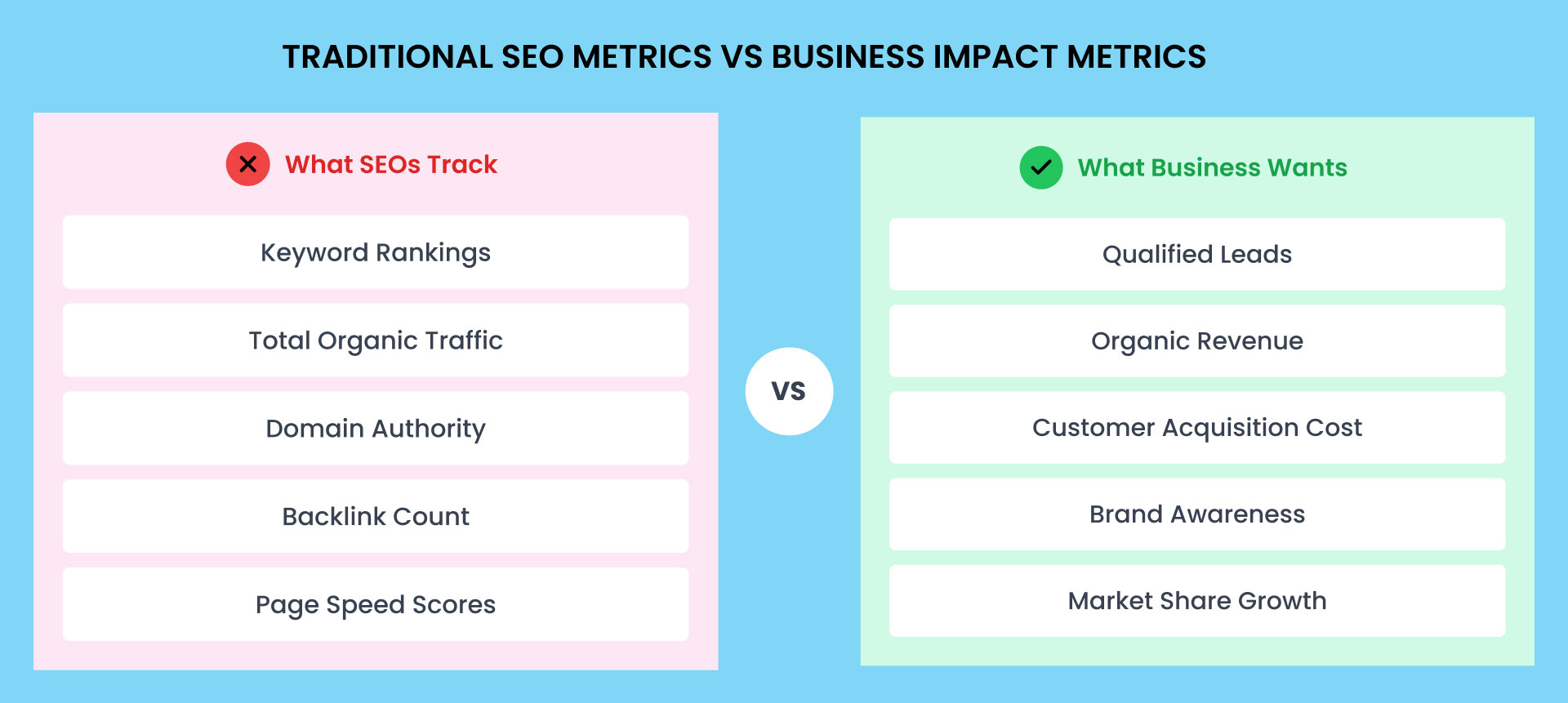
This knowledge gap explains why many eCommerce businesses struggle to justify their SEO investment. A performance measure like keywords ranks overall or traffic number does not always provide real commercial value. This is where DecodeUp can help fill that gap.
Ask yourself: What would make SEO a clear win for your eCommerce store in 2025?
Your response may look like:
Not one of these stated "rank #1 for [keyword X]."
These business outcomes drive growth and constitute the basis for any eCommerce solution you install.
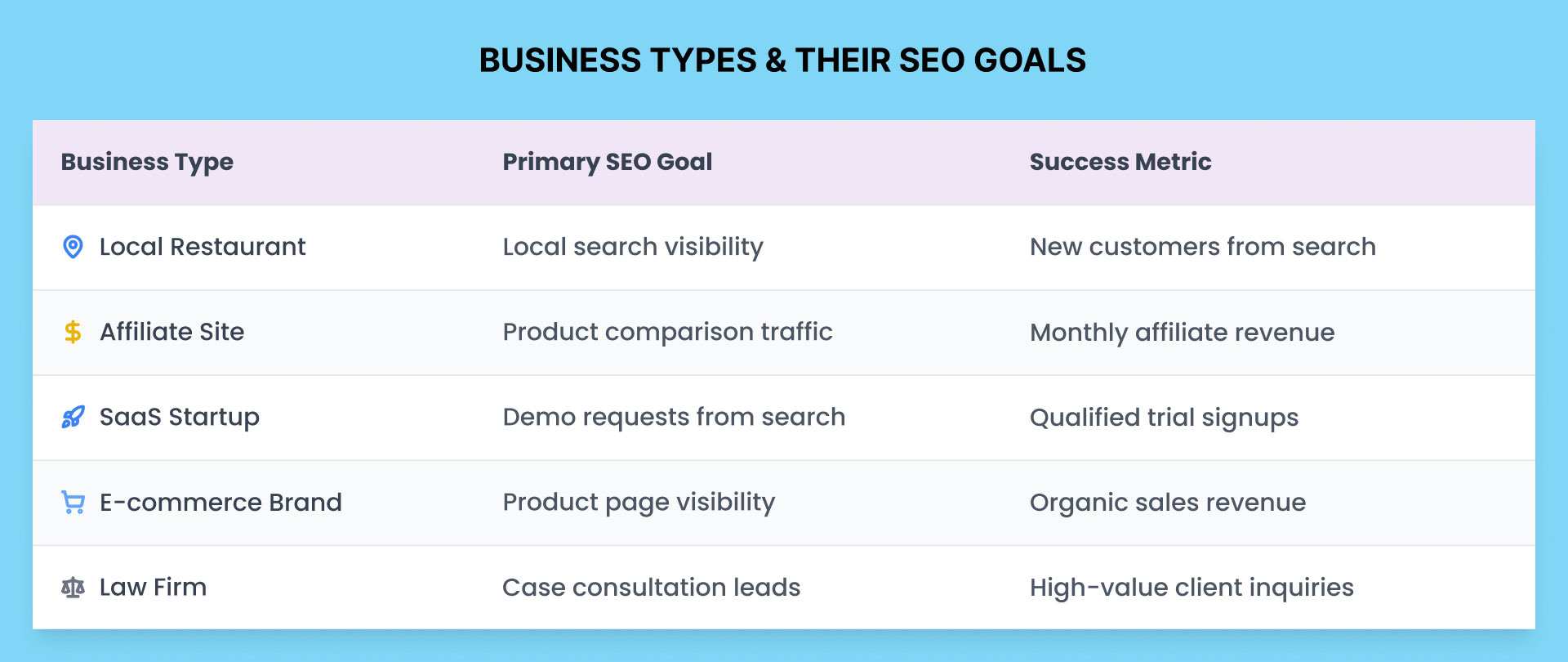
After you use the business goals, tie these to the eCommerce SEO initiatives you wish to take on that will move the needle on the overall attainment of business success.
Lead generation eCommerce (e.g., B2B stores, SaaS integrated stores, custom Shopify solutions):
Revenue-based eCommerce (dropshipping, retail, niche stores)
Local eCommerce (USA-based retailers who have either physical or hybrid storefronts).
Been battling with an organic lead slowdown? You're not alone.
DecodeUp's eCommerce solutions keep your Shopify store relevant in Google, AI Overview, and more.
What is your domain | Visibility Check
Measuring the genuine worth of eCommerce SEO in 2025 is full of difficulties. Users in the USA move from ChatGPT to Google, YouTube reviews, and even Reddit communities, before they even complete a lead form. AI tools disguise referral data. Privacy rules hinder tracking data accuracy. A zero-click search represents an engagement activity that doesn't even require a site visit.
Rather than fighting for attribution, take a directional trend eCommerce SEO strategy and monitor for leading signs that fit your eCommerce solutions.
Track these reliably:
Use qualitative data:
Skip the vanity metrics:
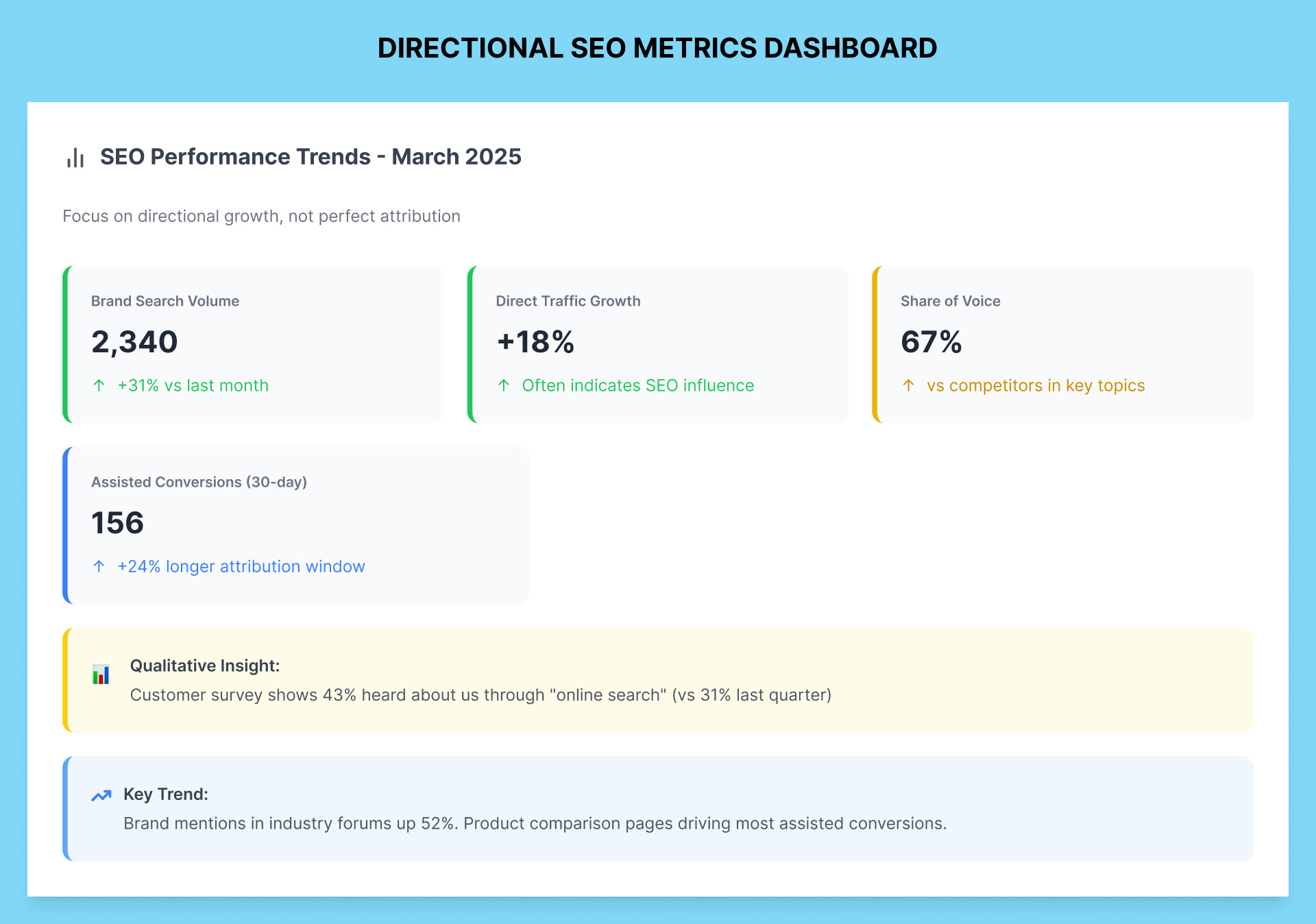
A single keyword is simply the tip of the cap for your eCommerce solutions.
In 2025, your clients in the USA use natural language, which drives them to ask inquiries regardless of the platform they are on and expect more than a list of relevant links. Your eCommerce SEO strategy should discover the specific terms as well as the queries your audience is searching check to qualify your lead.
It all starts with what you already know about your customers.
Before you open your first keyword tool, you already have a wealth of information that competitors might not access: client data.
For DecodeUp, we have unique insights into what eCommerce businesses want when creating a Shopify store and integrating ERP/CRM systems. Here is how to use client data for your eCommerce solutions:
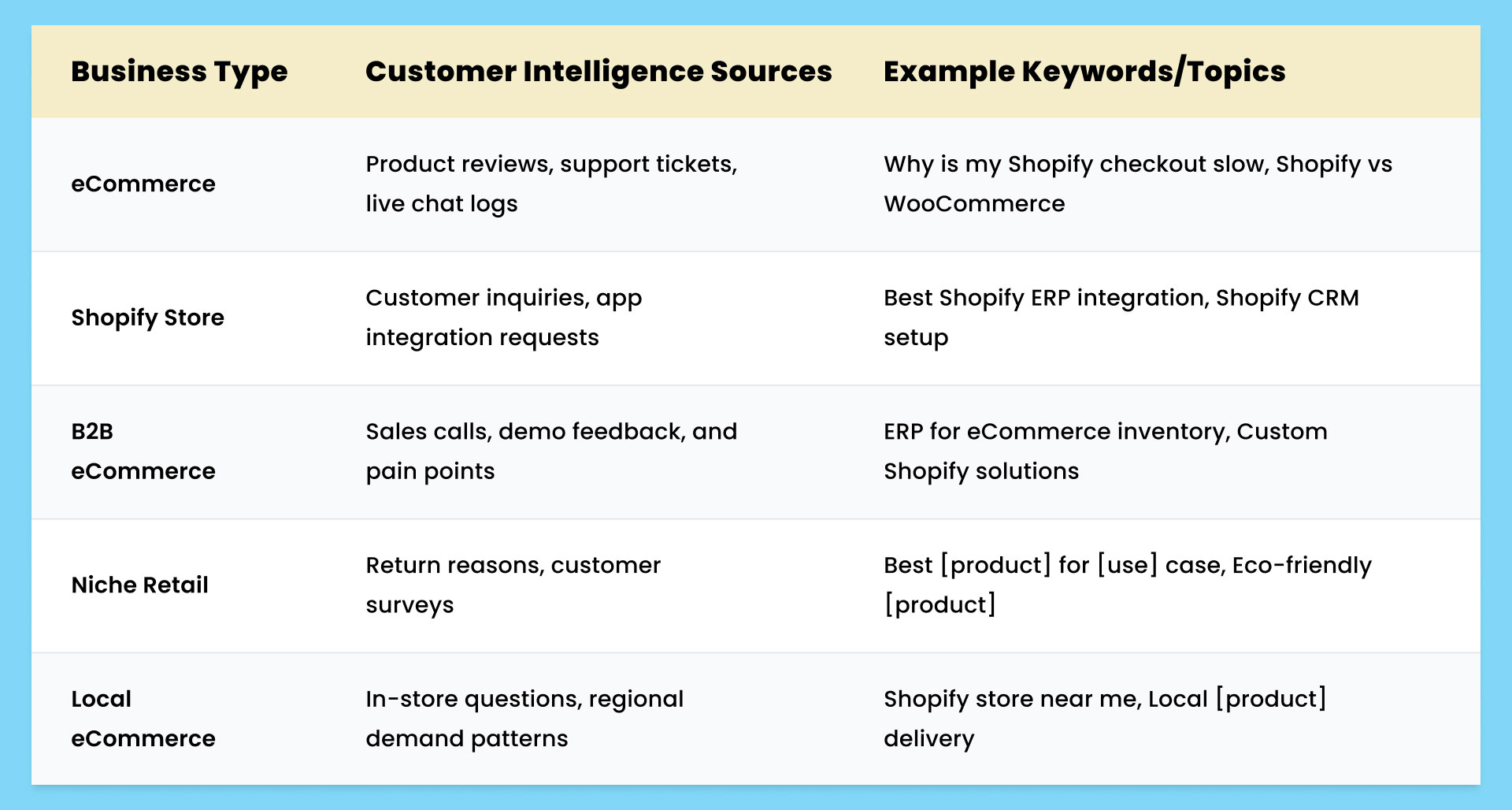
Assess the particular words your clients use when they talk about difficulties, ask questions, or express their ambitions. If a client says, "How do I sync my Shopify store with NetSuite?" you will see high-intent keywords like "Shopify NetSuite integration." These keywords are common among leads looking for eCommerce solutions.
This will help you build themes that search tools often miss, while also making sure your content focuses on what drives conversions.
Your competitors have done the hard job of researching keywords that increase eCommerce sales. Spend 30 minutes looking at their most popular pages to determine the marketing objective behind each one. This activity can provide you with 3 to 6 months of great content ideas for your eCommerce solutions.
Here is how you may figure out which content produces money for your competition using a program like Semrush:
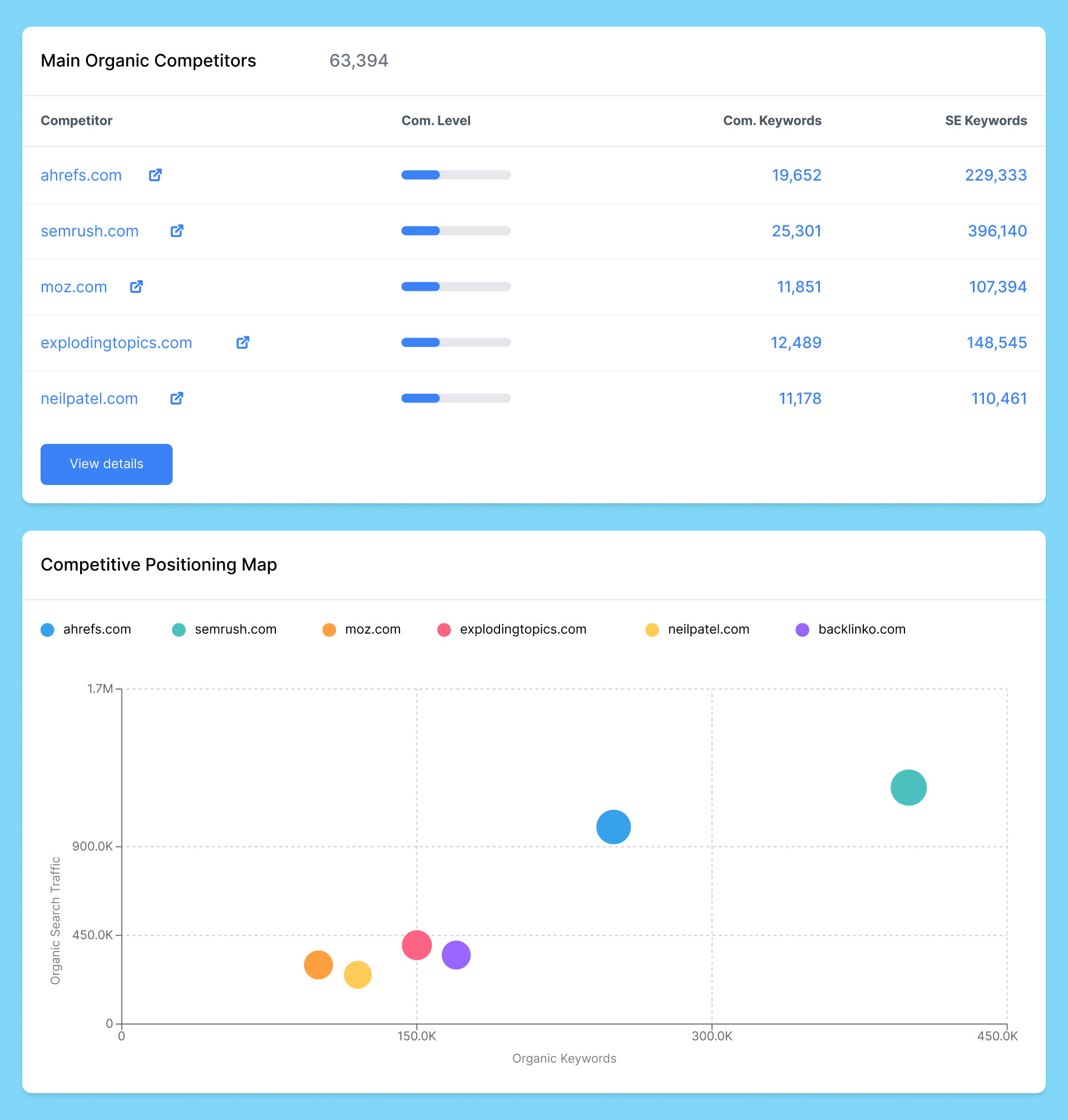
This outlines their most popular pages, organized by expected traffic. Be careful and focus on pages that lead to actual business results, not just blog traffic. Consider looking for:

Now that you have consumer insights and competitor intelligence, it's time to check and increase your eCommerce keywords across search platforms.
Google Autocomplete is a simple technique to check and find eCommerce SEO keywords.
Start typing a topic in the search window, and it will suggest topics based on actual searches in the USA. For example, typing "Shopify integration" would show:
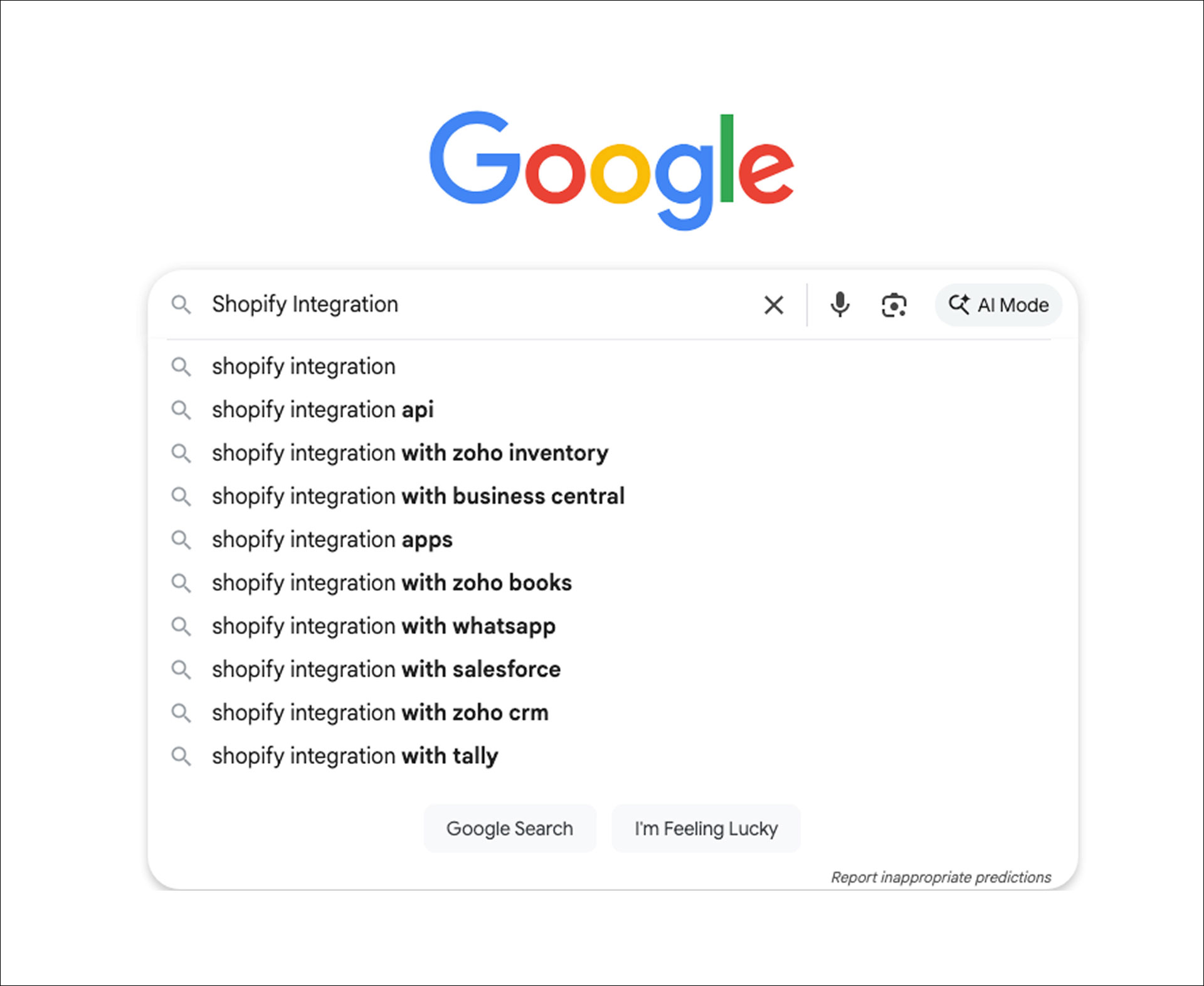
These long-tail keywords are targeted, have little competition, and are easy to rank for. Each one may be a product page, a blog entry, or a part of a broader guide on eCommerce solutions.
Customers are using natural language patterns with AI technologies like ChatGPT more than ever, especially for difficult eCommerce solutions such as ERP integrations. See how AI works in your sector.
For example: "What eCommerce solution should I consider?"

This shows the following:
These insights can help you focus on keywords that reflect how your audience in the USA searches for eCommerce solutions.
YouTube, the second-largest search engine, reveals how buyers look for eCommerce solutions differently than they do on Google.
Search for "Shopify ERP integration" and think about:
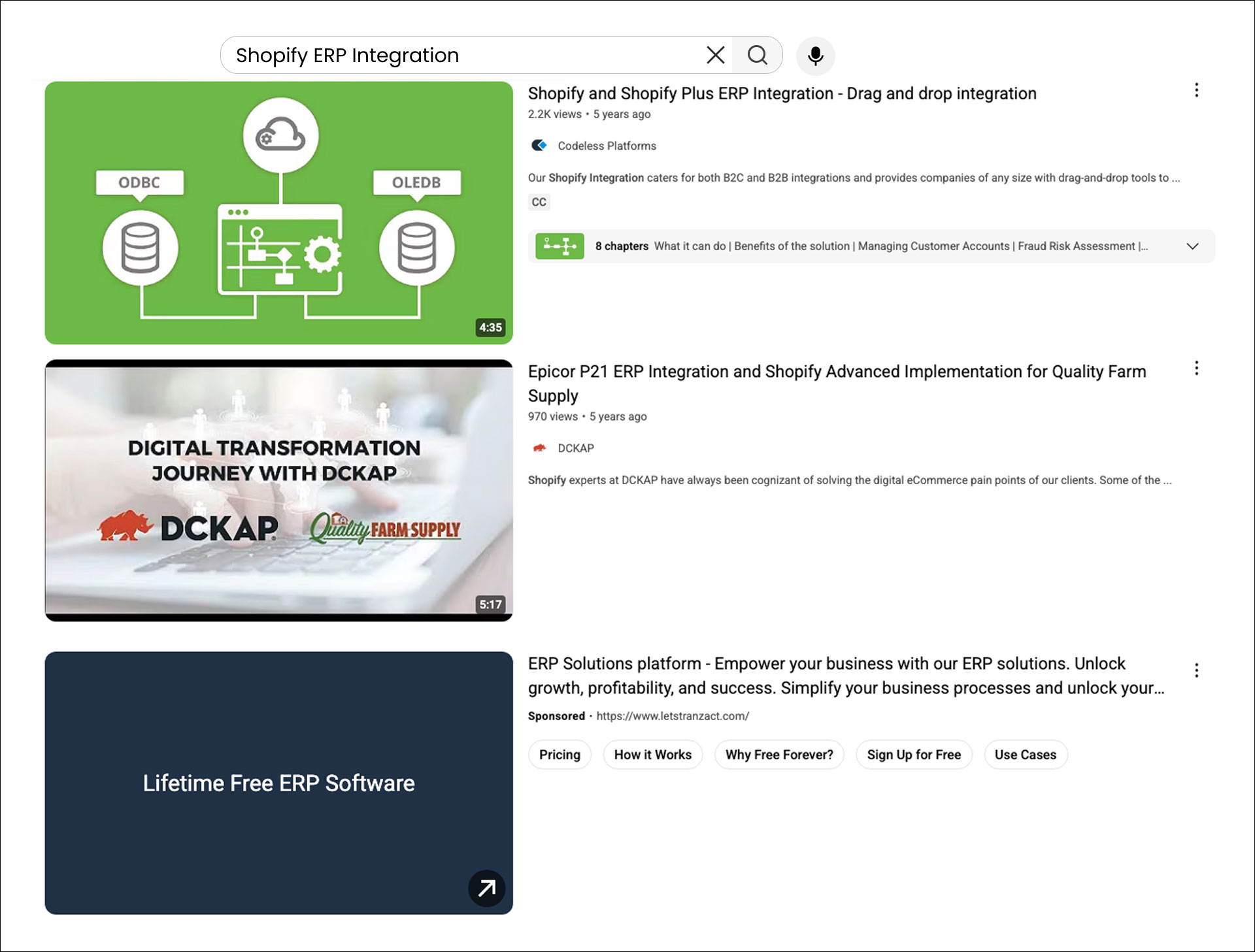
Reddit reveals unmet challenges and inquiries regarding eCommerce solutions that standard methods miss.
Search "Shopify CRM" or "eCommerce ERP" in related subreddits like r/ecommerce and r/Shopify. Look for:
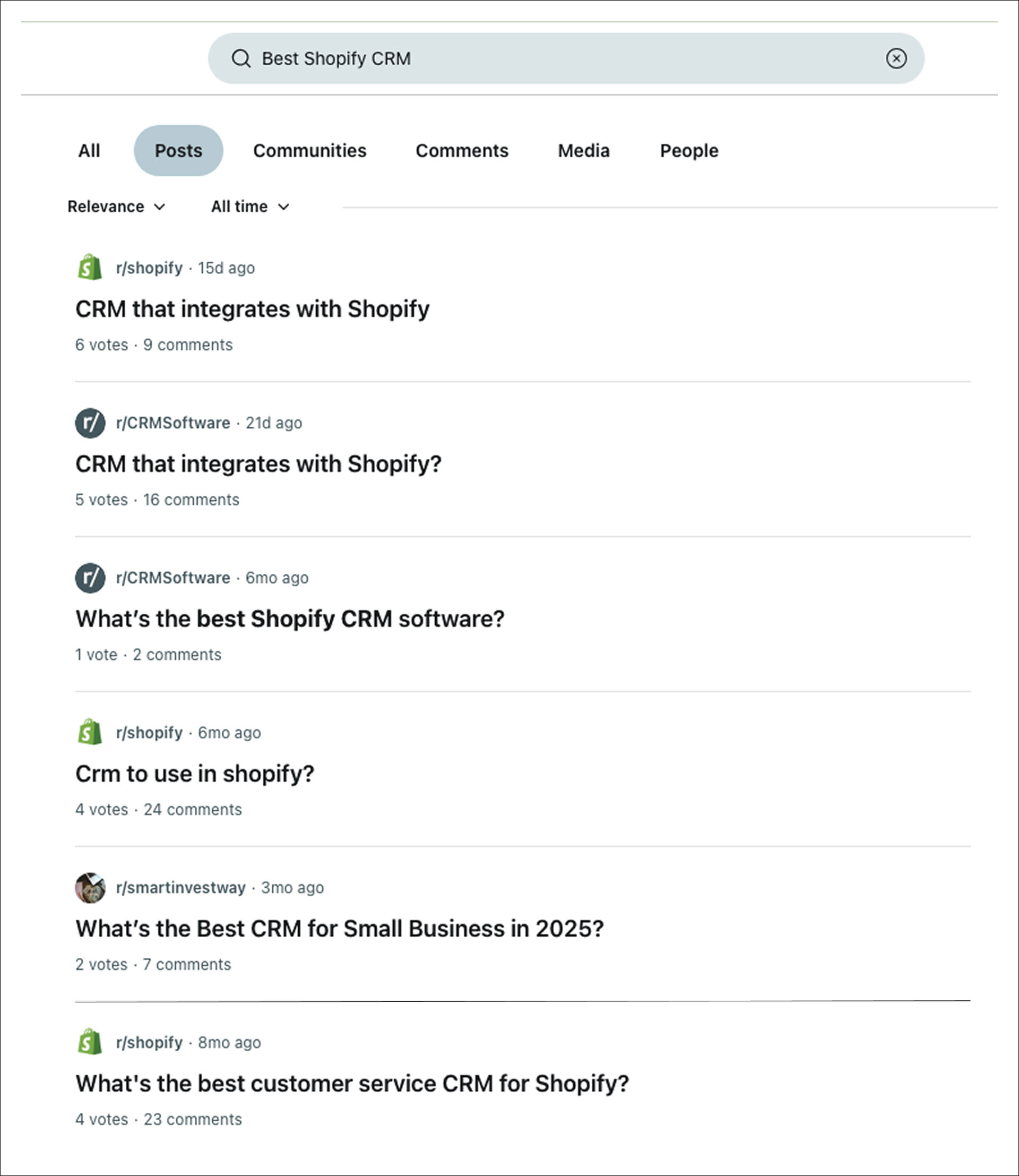
This fits with Search Everywhere Optimization. It involves looking at how your USA-based audience searches for eCommerce solutions on various channels. You don't need to generate content for every platform. However, recognizing what is available lets you create distinct sites that convert.
You should now have a basic list of eCommerce SEO keywords. You may use a keyword tool like Semrush to get the most out of your study.

Is content from AI tools like ChatGPT benefiting your competition?
Find out where your eCommerce solutions are losing opportunities and how to get those mentions.
Enter your domain | Visibility Check
If you're wondering and guessing what your USA-based clients want with your eCommerce solutions content instead of researching what ranks and converts, you're going to fall short. If you ignore this phase, you risk wasting months developing content that likely will never get published.
Get it accurate and you've learnt the format, depth, and angle you need to win with your eCommerce SEO strategy well before you write your first word.
Search your goal keyword on Google and analyze the first page. The results demonstrate exactly what your audience prefers and what Google awards for eCommerce solutions.
Look for these crucial patterns:
YouTube audit: Even if you don't notice video content in the primary search results, search YouTube for your term (for example, "Shopify ERP integration"). Often, popular tutorials or reviews will demonstrate actual demand for eCommerce solutions that do not show up in Google search results.
Now that you know what is ranking, look at the reasons why, and evaluate how DecodeUp may improve the offers that are ranked.
Click through the top 5 to 10 results for your eCommerce solution keywords and look at:
Craft a simple brief for each eCommerce solution keyword or topic to capture your analysis. Prepare basic information for each eCommerce solution keyword or topic to document your analysis. This can assist you in deciding what areas to address while generating content that ranks and generates leads.
Key components to capture:
Focus Keyword: “Shopify NetSuite integration”
User Intent: Find out how to integrate Shopify and NetSuite for inventory management
Preferred Format: Step-by-step tutorial with graphics
Required Length: About 2,500 words, including customer case studies
Key Distribution Platforms: YouTube instructional and software pages
Content Opportunity: Competitors are lacking pricing details and real customer instances
Business Objectives: Generate leads for DecodeUp’s unique Shopify integration services
This brief ensures you understand what to design, how much detail to provide, and where you can distinguish yourself from other eCommerce solution suppliers.
Before you start developing content, ask yourself:
If you responded "no" to any of these, think about modifying your keywords or adjusting your eCommerce SEO strategy to succeed.
Are you not ranking for the eCommerce solution keywords you want most?
Let DecodeUp examine the SEO of your Shopify store and discover the holes so you can generate leads.
The goal is to create content for eCommerce solutions that satisfies search intent and gives US consumers confidence that they are in the right place. The most effective content is understandable and useful, and the author's experience is evident.
Content for eCommerce solutions that work gives searchers what they want in the appropriate format.
Search intent: “I need reliable Shopify apps for ERP integration.”
Content format: Curated listicle
We rank our DecodeUp guide based on our strict selection criteria. We only feature apps that generate leads for our eCommerce solutions that we have tested in practical Shopify stores. Every entry contains:
Because it is based on surfing the real experience of using the app rather than research, it does more than just rank; it transforms USA shoppers into leads.
High-performing eCommerce solutions require content that has a hook, something interesting enough for customers to link to, share, or refer to.
We rank "Shopify ERP integration cost" in our guide, for instance, and many people use it. Why? The price ranges were made clear, actual data was supplied, and summaries by integration type (e.g., NetSuite vs. Zoho) were offered.
Clarity was the hook. Pricing was made very easy to understand using charts and tables, which is beneficial for bloggers and eCommerce entrepreneurs. It is a vital resource for eCommerce solutions because of its unique insights rather than recycled content.
Ask yourself:
A "yes" indicates that you've got it perfect.
If the content of great eCommerce solutions is just a wall of text, it loses impact.

Search intent: "How do I migrate my Shopify store correctly?"
Format of content: Downloaded template and action guide
For client migrations, DecodeUp uses our checklist, which is simple to use and quick to understand. It includes:
It comes in an easy-to-read way, offers a downloadable template for American store owners, and drives leads by highlighting DecodeUp's proficiency with eCommerce solutions.
Google’s E-E-A-T (Experience, Expertise, Authoritativeness, Trustworthiness) will be important in 2025. For eCommerce solutions, E-E-A-T means presenting genuine examples of experience, like how DecodeUp helped a client optimize a Shopify-NetSuite connection instead of simply adding author profiles. Use ERP experts to provide relative authority.
In challenging and competitive eCommerce niches, general advice doesn't cut it. Provide the distinctiveness that only you can provide:
AI is amazing for building outlines of eCommerce solutions content or producing concepts, but doesn't And won't replace DecodeUp's decade of real Shopify experience. Use AI to develop a base of recommendations or examples, but be sure to preserve your sound so that you interact with clients on their level.
Want content that converts? Let DecodeUp design eCommerce solutions content that gets ranked and generates leads. Get a Free Content Audit | Get Started
On-page SEO in 2025 is focused on clarity and context for your eCommerce solutions.
You need content that's clear for buyers in the USA, search engines, and AI systems that are pulling answers from your pages. This is based on what knowledgeable SEOs have known to work and isn't new, yet the cost of bad form or unclear message could be bigger today than ever, because vague messaging gets buried quickly.
Let's explore one of DecodeUp's web pages that performs best: the Shopify ERP Integration Guide.
This guide ranks for over 80 keywords, including "Shopify ERP integration" and "how to sync Shopify to NetSuite." It is possible to attain these results not by packing keywords, but rather by being clear, complete, and semantically acceptable.
Your page title should be straightforward and incorporate keywords:
Shopify ERP Integration: Improve Your eCommerce Operations
Each part should have clear, detailed headings (e.g., "Choosing the Right ERP for Shopify," "Step-by-Step Sync Process").
Headings work as a table of contents. Shoppers scanning headers should have an immediate comprehension of your eCommerce offerings.
Make URLs short and to-the-point for eCommerce solutions: decodeup.com/shopify-erp-integration
Avoid parameters, dates, or directories. Make it easy to remember and share with fellow Americans looking for eCommerce solutions.
Link to related eCommerce solution content with informative anchor language example, “Shopify CRM setup guide” or “custom Shopify development services.”

These links provide context for shoppers and for Google, which adds to your authority inside eCommerce solutions.
Additionally: The Complete Guide to Internal Linking for eCommerce
Rather, you simply use "Shopify ERP integration" many times, use comparable words in a natural way (such as "inventory syncing," "NetSuite for e-commerce"). We are marketing eCommerce solutions as a whole, which helps us meet the needs of the users and the search engine.
Semantic Keyword Relationships for eCommerce
Additionally, what is Semantic SEO for eCommerce?
For eCommerce solutions, employ basic layouts, brief paragraphs, clear headings, and visuals that match both your solutions and your visitors' experience. Thankfully, our Shopify ERP Integration Guide has a simple structure (that's easy to keep shoppers engaged), making it straightforward for an AI to understand the content hierarchy.
Before producing your eCommerce solutions content, examine the following content construction blocks:
This will develop eCommerce solutions content, with the careful structure that modern search engines want.
Do not overlook the basics for eCommerce solutions:
Meta Descriptions
Write appealing summaries: “Find out how to sync Shopify with top ERPs like NetSuite for eCommerce success.” Clear meta descriptions help underline the relevant theme.
Image Optimization
Page Speed
Slow pages hurt rankings and the user experience. Read the page speed article for eCommerce solutions pages by utilizing Google PageSpeed Insights.
Mobile Responsiveness
Make sure your content can shine on all devices for buyers in the USA.
Are you unclear on the content? Let DecodeUp improve your eCommerce solutions pages to rank and convert. Connect with us to improve content clarity.
By 2025, link building will still be necessary for eCommerce solutions, but the value has transformed. You’re not simply concentrating on backend backlinks (though it’s significant). You are making an attempt to understand how search engines and AI models comprehend your brand, like DecodeUp. Think like a professional PR person in getting leads from US-based shoppers.
Your goal is absolute visibility on the web. Coverage from authoritative backlinks to mentions in forums and blogs, then to mentions in AI-generated responses. For eCommerce solutions - focus on:
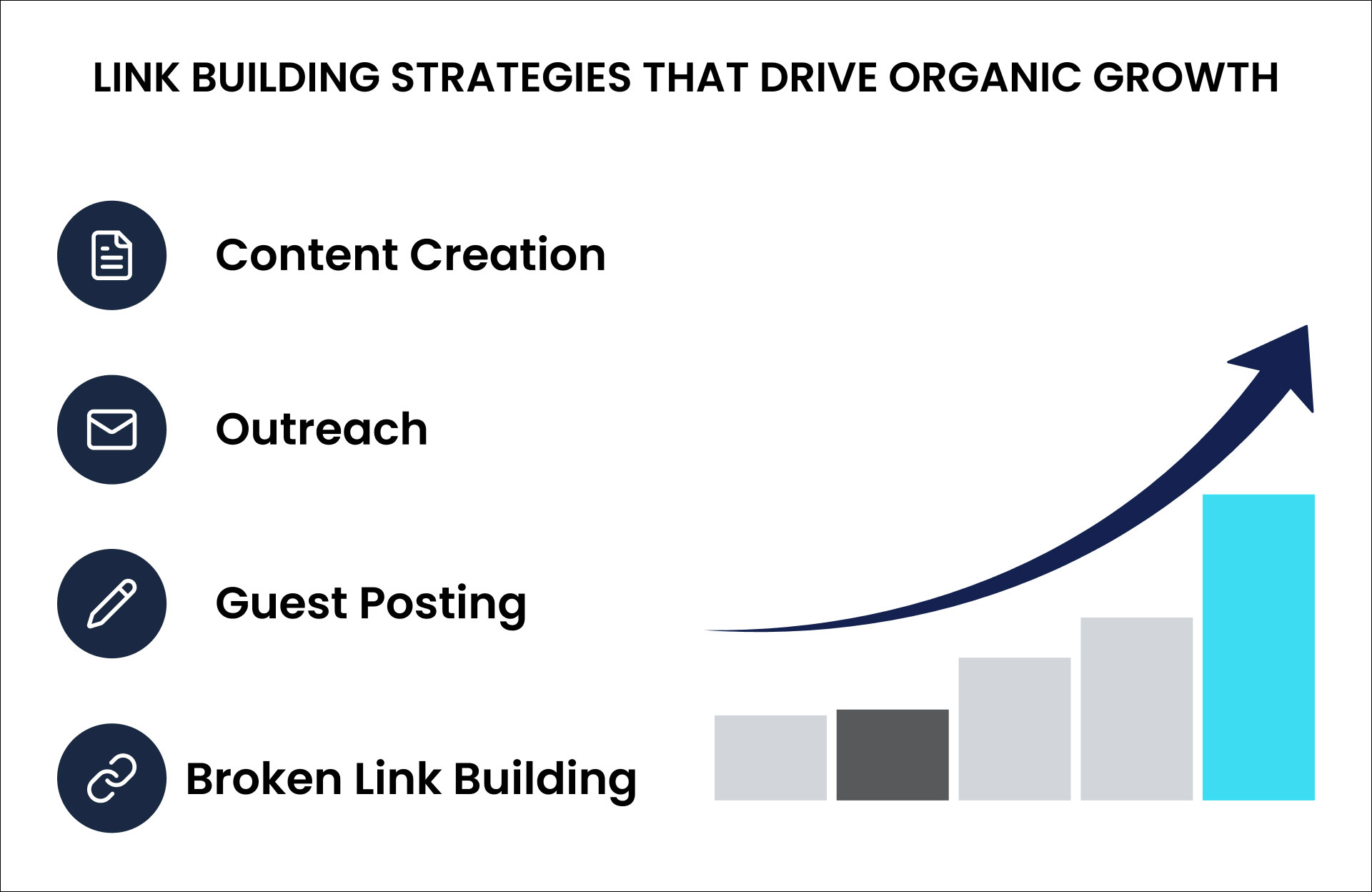
Examining competitor connections is an exceptionally rapid and effective technique to uncover impactful prospects for eCommerce solutions.
The SEO strategy is simple:
Look at the context. Are competitors:
These patterns show the linkages that eCommerce solutions are earning from content.
Here’s how to do it with Semrush:
Statistics are a significant link attractor, especially for eCommerce apps, when set out correctly.
Our DecodeUp research on "Shopify ERP Integration Success Rates" earned numerous connections only by presenting:
This page gained links from eCommerce Times and Shopify Plus articles.
No proprietary data? You can:
Journalists and bloggers are looking for professional quotes on eCommerce solutions. By replying to relevant prompts, you can earn backlinks from media, tech blogs, or B2B publishers.
Real-life Example: A writer using LinkedIn was looking for examples on Shopify-NetSuite integrations for a piece for TechCrunch. DecodeUp produced a case study that showcased how we simplified a client's inventory, and we received a link for it.
Think about requests related to do with Shopify, ERP, or eCommerce systems. Watch:
Are you losing out on high-value links? Let DecodeUp enhance visibility for your eCommerce solutions in order to drive leads.
Get a Free Link Analysis | Get Started
To remain accessible to customers residing in the USA, your content must stay fresh, accurate, and relevant. It is what drives leads and keeps your Shopify store competitive.
For instance, DecodeUp revised our Shopify ERP Integration Trends Guide in March 2025 and experienced a 65% jump in organic traffic.

Generally, preserving content can produce a larger ROI than constructing new pages from the ground up. In the fast-paced eCommerce market, products and processes such as ERP integrations lose relevancy and subsequently lose rankings.
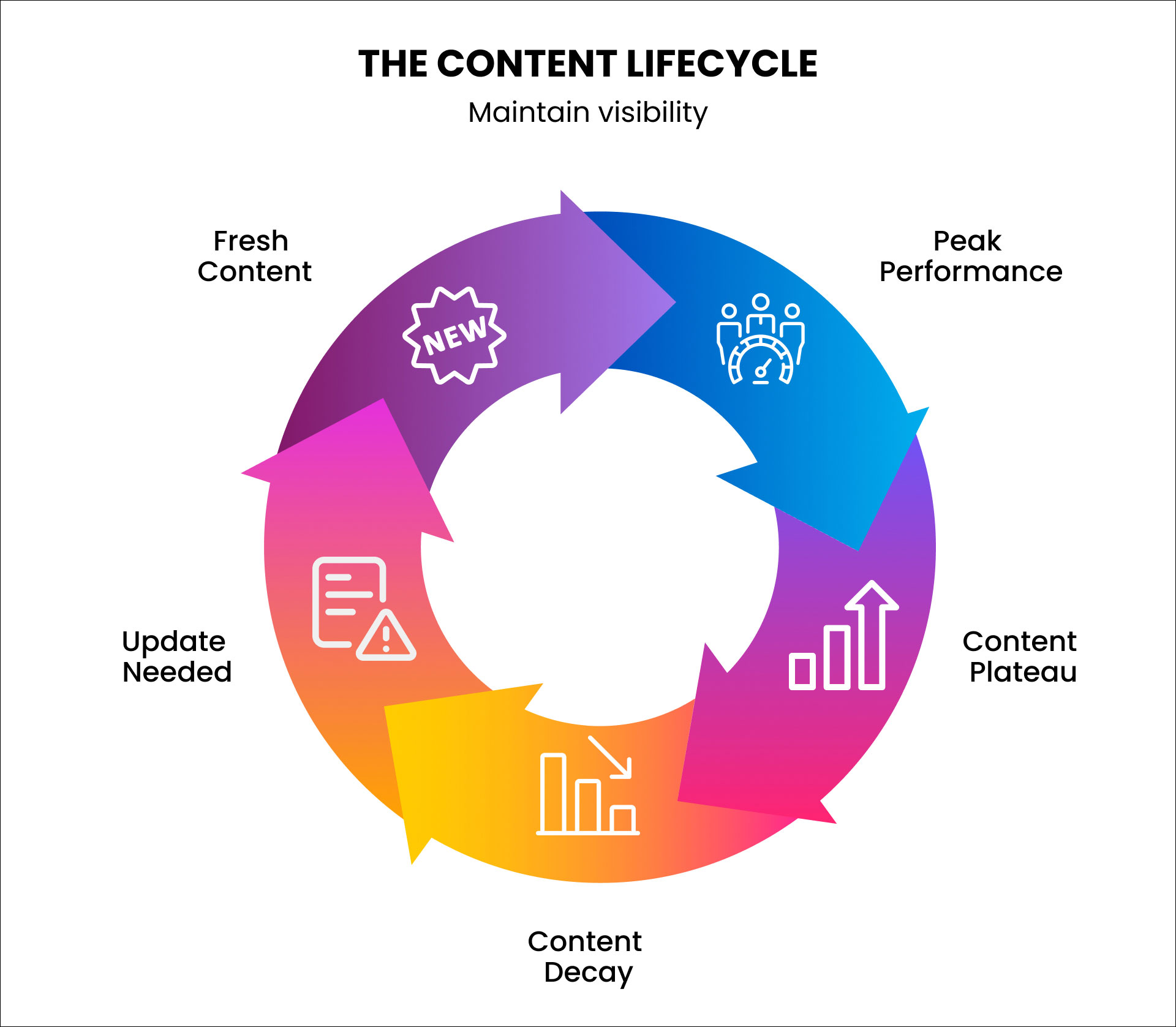
Managing your eCommerce solutions content library can become difficult as it increases substantially without a structure in place.
DecodeUp offers a three-level structure of content updates:
We focus on early optimizations, selected upgrades, and late rewrites to get the most out of our resources. Most eCommerce solutions pages require optimizations on a regular basis, while service guidelines and crucial pages may require upgrades or rewrites.
Note regarding video: You can't change a published video, but you can make a new video without worrying about cannibalization. For example, if a guide on developing a Shopify integration went well, you can write a new version with your updated knowledge regarding eCommerce solutions.
Strategic acquisitions might speed up your eCommerce solutions' content.
Real Example: After finding two DecodeUp pages, "Shopify Inventory Management" and "ERP for Shopify," were targeting similar keywords, we decided to integrate them together into a whole guide.
The page is now ranking top 5 for "Shopify ERP solutions" and generated 120k clicks in 12 months - an astounding 500% rise.
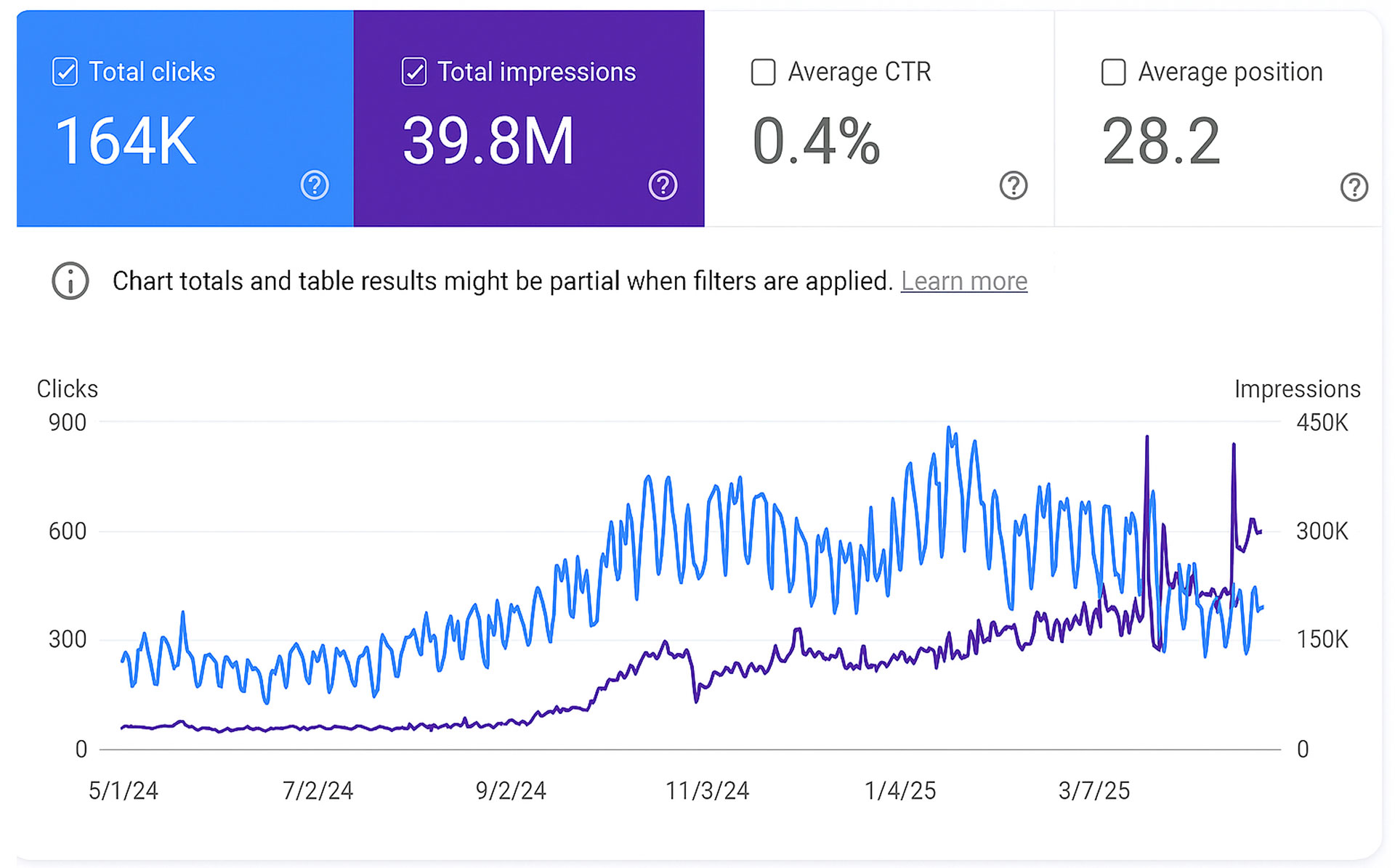
Consolidation is useful when:
Think of updates as a health check for your eCommerce solutions content. Is it correct? Does it solve the problem of the shopper? Are visuals current?
Check for:
Make any earlier screenshots (e.g., outdated Shopify dashboards) current. For eCommerce solutions, make sure your content represents what is happening today (e.g., growing trends like AI-powered inventory syncing).
This phase is a worthwhile investment in your eCommerce SEO strategy, typically generating results faster than creating new content.
eCommerce SEO in 2025 is not that much different; the principles still matter. There is just a better understanding, which makes SERP tasks more challenging.
Expectations from USA shoppers, search engines, and AI have evolved. This article is not an expose of new eCommerce - it can assist in transforming your practice. You are generating clarity, trusted relations, and visibility through the platforms and the conversations that occur.
It's tougher than previously, but that's a trigger. The folks who have experience, care about their subject, and do the job will succeed. At DecodeUp, we believe amazing eCommerce SEO strategy yields great results, but even better, it makes the online a better place for shoppers.
Does your content on your eCommerce solution feel old? Let DecodeUp boost your Shopify pages and bring new leads. Get a Free Content Audit | Get Started.